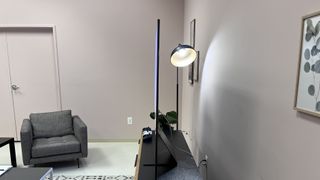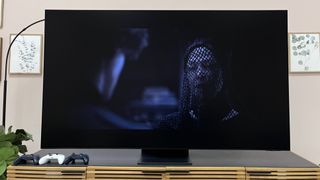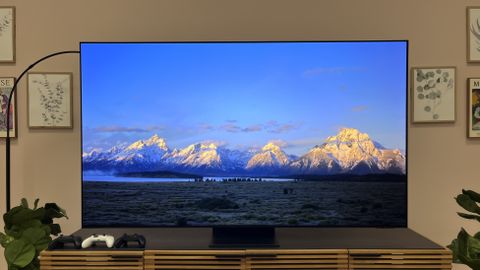Early Verdict
The Samsung S95D is the brightest OLED TV we’ve yet tested, and although our time with it was relatively short, it’s looking to be one of the top TV prospects for 2024. There are many great things to say about its picture performance, but the highlight here is OLED Glare-Free tech, a new enhancement that virtually eliminates screen reflections when viewing in bright rooms.
Pros
- +
High brightness for OLED
- +
Effective anti-glare screen
- +
Great gaming features
Cons
- -
Pricey
- -
No Dolby Vision HDR support
Why you can trust TechRadar
The new Samsung S95D takes OLED TV's brightness to a whole new level. In 2022, Samsung shook up the TV world with the introduction of its first QD-OLED TV, the Samsung S95B. And while Samsung prefers to call its QD-OLED models simply “OLED” TVs, the company offers a unique take on the technology – specifically, the combination of an OLED display panel with a Quantum Dot layer to enhance brightness and extend color volume.
We were big fans of the S95B as well as its successor, the Samsung S95C, which took the crown as the Best OLED TV at the TechRadar Choice Awards 2023. That model introduced a 40% brightness boost and also managed to fix any issues with black-level consistency we had noted on its predecessor. And now we have the new Samsung S95D, which further pushes the brightness envelope while adding enhancements such as OLED Glare-Free technology to improve picture performance in bright rooms.
Samsung invited me to its New Jersey facility to do a hands-on test of the 77-inch version of the S95D in a living room-like space with good lighting control. During my session, I was able to make a full set of measurements and get substantial eyes-on time with the company’s new flagship OLED TV, which is very different from its predecessor due to the new anti-glare screen. Read on for my thoughts on that topic, but first, let's cover the Samsung S95D’s pricing, features and design.

Like the S95C series, the S95D series is available in 55-, 65-, and 77-inch screen sizes. The Samsung S95D series gets a price bump over last year’s S95C series, though if the S95C’s history is to be repeated, those prices should start falling as early as this summer.
- 55-inch: $2,599 (around £2,050 / AU$3,975)
- 65-inch: $3,399 (around £2,690 / AU$5,200)
- 77-inch: $4,599 (around £3,640 / AU$7,035)

A glare-free OLED TV
Screen glare is a pain point for OLED TVs, which have struggled to deliver satisfactory pictures in bright room lighting conditions due to their limited brightness compared to mini-LED examples of the best TVs.
With the S95D, Samsung has dealt with that issue directly by incorporating an anti-glare screen it calls OLED Glare-Free technology. According to the company, the new tech has“no negative effects on viewing angle or contrast and no color distortion,” and having now seen it in action, I can confirm that the S95D’s screen is completely free of reflections even with room lights turned on (see the image below).
Along with new screen tech, the Samsung S95D has a new NQ4 AI Gen 2 processor to upscale lower-resolution images to 4K and make possible features, such as OLED HDR Pro to optimize dynamic range and color detail as well as Real Depth Enhancer to intelligently boost contrast on foreground objects in images.
The Samsung S95D’s audio features include 4.2.2-channel built-in speakers powered by 70 watts; Object Tracking Sound+ to create an immersive sound experience from the TV’s speakers alone while accurately locking sound effects to specific areas of the screen; and Active Voice Amplifier Pro, which intelligently boosts dialogue and sound effects to enhance their impact.
Samsung TVs regularly rank among the best gaming TVs and the S95D is no exception. Its four HDMI 2.1 ports accept a 4K 120Hz input from gaming consoles (and 144Hz for PC gaming), and there’s support for FreeSync Premium Pro. Samsung Gaming Hub offers a one-stop shop for cloud-based gaming from apps including Xbox, Nvidia GeForce Now, Utomik, and more, and the new Game Bar 4.0 menu features an AI Auto Mode option that can recognize game genres and adjust picture and sound settings automatically. I measured input lag on the Samsung S95D in Game mode at 9ms – an excellent result that slightly bests last year’s S95C.
The Samsung S95D’s incredibly slim bezel is matched with an under-11mm panel depth. While I tested the TV with its pedestal-style stand attached, it would look great mounted to a wall, which is something its One Connect box for source hookups makes easy. Like other Samsung TVs, it has a SolarCell remote control that draws and stores power from room lighting and doesn’t require batteries.

The brightest OLED TV yet
Peak brightness on the Samsung S95D measured just shy of 1,800 nits, making it the brightest OLED TV we’ve tested yet. That measurement was made in Movie mode on a white window test pattern covering 10% of the screen area, while a full-screen white pattern measured around 325 nits. Full-screen brightness is another important factor for daytime viewing, and though the S95D falls short here compared to its mini-LED competition, including the new Samsung QN900D 8K TV, which measured 520 nits on the same test, the new Samsung QD-OLED’s performance improves on last year’s model.
The S95D’s color gamut coverage was also excellent, measuring 99.9% for UHDA-P3 and 89% for BT.2020. Combined with its high peak brightness, these numbers mean that Samsung’s top QD-OLED is equipped to make short work of any HDR source you throw its way (Dolby Vision excepted, since the S95D like other Samsung TVs only supports the HDR10, HDR10+, and HLG high dynamic range formats).
For obvious reasons, I started my viewing with the room lights on. It was almost uncanny how well the Samsung S95D dealt with overhead lights and lamps in the room. Black areas in pictures were free of contrast-killing reflections, and even when I stood directly in front of the screen I didn’t see a hint of my mirror image. There was also good detail in shadows when watching movie scenes, which I normally don’t expect to see in such conditions.

As good as it looked in the light, with the room dimmed, the Samsung S95D’s picture took on a much punchier character (see the image below), with excellent contrast on HDR sources. In both environments, images had crisp detail, refined highlights, and natural-looking color.
Nonetheless, having done hands-on tests of Samsung’s new Neo QLED mini-LED TVs during the same session, I was surprised to find both color richness and contrast on the S95D slightly lacking compared to my relatively fresh visual memory of the other TVs. Was OLED Glare-Free tech the culprit? To go by the measurements alone, Samsung’s new top QD-OLED should deliver uncompromised picture quality. But it also seemed there was a slightly veiled quality to the image, though it was ultimately tough to put my finger on it.
It will take a full review to thoroughly assess the S95D’s performance, but I can confirm that Samsung’s flagship QD-OLED delivers stunning-looking pictures in both bright and dim lighting. Is it Samsung’s best TV for 2024? That question will also require further testing before making a final call. For now, let’s say that Samsung’s new screen glare-fighting screen tech works as advertised, and the rest of the S95D is equally impressive.
You might also like

Al Griffin has been writing about and reviewing A/V tech since the days LaserDiscs roamed the earth, and was previously the editor of Sound & Vision magazine.
When not reviewing the latest and greatest gear or watching movies at home, he can usually be found out and about on a bike.
What is a hands on review?
Hands on reviews' are a journalist's first impressions of a piece of kit based on spending some time with it. It may be just a few moments, or a few hours. The important thing is we have been able to play with it ourselves and can give you some sense of what it's like to use, even if it's only an embryonic view. For more information, see TechRadar's Reviews Guarantee.

